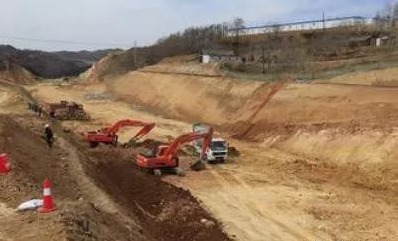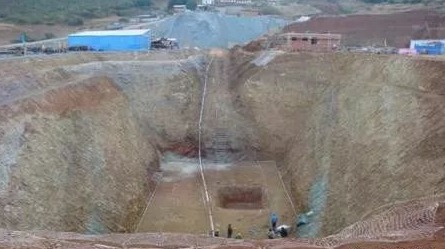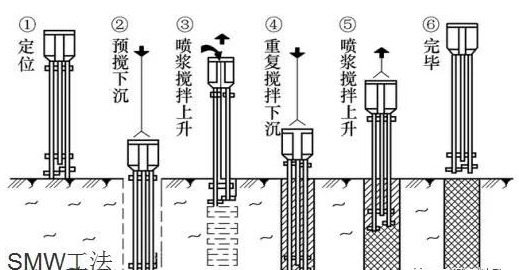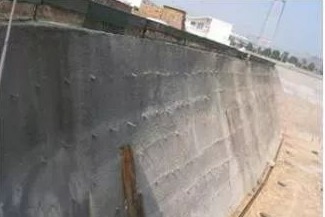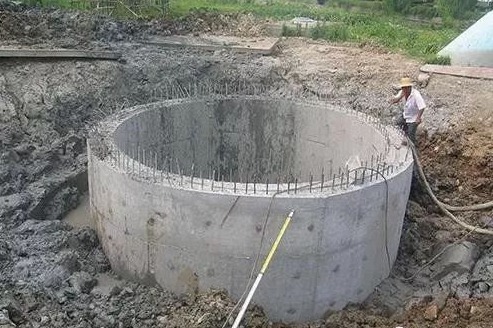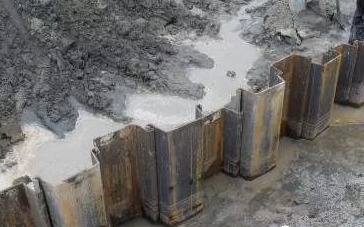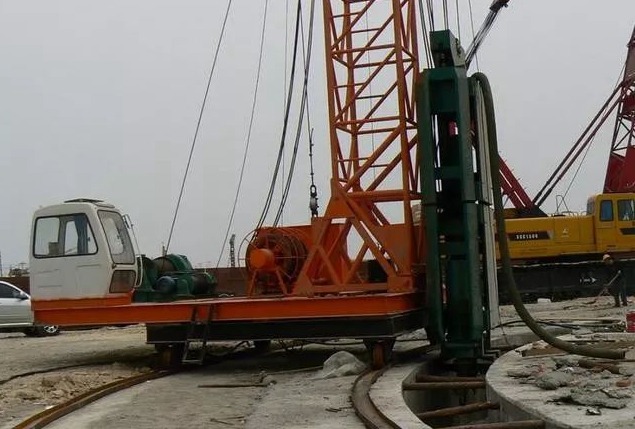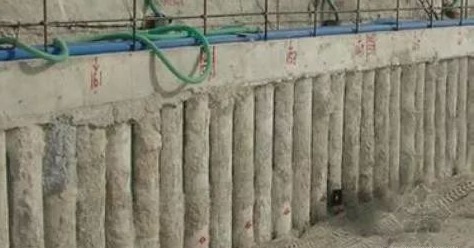1. Slope excavation (Large excavation) method
There are no supports or supporting structures in the pit; it is convenient for the construction of large-scale excavating machinery and the main structure; the construction speed is fast and the cost is low; it is suitable for occasions with low groundwater levels and open sites.
Advantages: No enclosure or support structure (high permeability strata must be equipped with water-stop structures), easy excavation, quick excavation, easy construction of internal civil structures, and low cost.
Disadvantages: The amount of unearthed material is relatively large. When there is no soil pile site, backfilling is required, which will increase the cost. The applicable excavation depth is not large (generally no more than 10m). When there is no water-stop structure, the groundwater level is required to be low or precipitation measures are required to open the site. There are no important protective buildings around. Slope protection measures must be installed during rainy season construction or long construction periods. This will increase cost
2. Gravity cement-soil wall method (shallow trench support)
No pollution, no noise, no vibration, little impact on the surrounding environment, and low cost. There is no support in the pit, which facilitates the construction of large-scale excavating machinery and the main structure, and the construction speed is fast.
Advantages: no support, low cost
Disadvantages: The strength of cement-soil mixing piles is low (generally 0.8MPa). The construction of cement-soil mixing piles has a greater impact on the surrounding environment. Trapezoidal overlap construction is required. The cement-soil mixing piles require a large amount of cement (13~15%). A larger amount is required. The deformation of the foundation pit at the construction site is large.
3. High-pressure jet spray pile method
Pile bodies of various diameters (single pipe, double pipe, triple pipe) can be formed to avoid underground pipelines and obstacles conveniently and flexibly; the pile body can be used as a water-stop curtain for foundation pits and can form a self-standing dam body without any obstructions in the pit. Support, is convenient for large-scale excavation construction, with no pollution, no noise, no vibration, and little impact on the surrounding environment.
(1) The high-pressure jet grouting method is suitable for treating foundations such as silt, silty soil, fluid plastic, soft plastic or plastic clay soil, silt, sand, loess, plain fill soil, and gravel soil.
(2) When the soil contains a lot of large-grained stones, hard clay soil, a large number of plant roots, or too much organic matter, it will hurt the silt and peat soil as well as the collapsible loess foundation of existing buildings. For reinforcement, its applicability should be determined based on field test results. Its applicability and technical parameters should be determined through high-pressure jet grouting tests.
(3) The high-pressure jet grouting method should be used with caution in foundation projects where pebbles, boulders, and boulders in bedrock and gravel soil have a skeleton structure, where the groundwater flow rate is too large, and where water has surged. The groundwater is corrosive and should be used with caution.
(4) The high-pressure jet grouting method can be used for foundation reinforcement of existing buildings and new buildings, water-stopping curtains for deep foundation pits, soil or water retaining on slopes, reinforcement of the bottom of foundation pits, prevention of pipe surges and uplifts, and large-diameter underground pipelines. Enclosure and reinforcement, soil reinforcement or waterproofing of subway projects, reservoir dams, sea walls, river embankments, anti-seepage reinforcement of dam bodies and foundations, construction of underground reservoir interception dams, etc.
Advantages: It can be used as a gravity retaining wall, and water-stopping structure, and can also be inserted into shaped steel as an enclosure structure. The strength is higher than that of soil-cement mixing piles (generally 1.2~2.0MPa). The impact on the surrounding environment during construction is smaller than that of soil-cement mixing piles. Obstacles encountered Easy to handle and flexible, large diameter (single pipe 0.6~0.8m, double pipe 0.8~1.2, triple pipe 1.2~1.5m, up to 2.5m under special conditions)
Disadvantages: The cost is higher than that of cement-soil mixing piles, and the cement consumption of cement-soil mixing piles is larger (20%)
4. Soil nail wall method
Suitable for clayey soil layers with low groundwater levels. The walls of the foundation pit and the soil work together to actively carry the load and have small deformation. The construction speed is fast and does not affect the construction period. There are no supports in the pit, which facilitates the construction of large excavating machinery and the main structure. There is no pollution, and the impact on the surrounding environment is small and the cost is low.
Soil nail walls are not only used for temporary supporting structures but also for permanent structures. When used for permanent structures, it is advisable to increase the thickness of the sprayed concrete surface layer and give due consideration to its appearance.
The main application fields of soil nail walls are 1. Underpinning foundation; 2. Foundation pit retaining or shaft 3. Retaining wall on slope surface; 4. Stability of slope surface; 5. Combined with anchor retaining wall to form slope surface protection
Advantages: unsupported construction is fast, easy to dig, and easy to construct internal civil structures. Compared with gravity-type retaining walls, the deformation is smaller and the cost is lower.
Disadvantages: Excavation must be in layers. Water-stop curtains must be installed when the groundwater level is high in soft soil areas, which will increase the cost. It is difficult to control the quality of the anchor body and the soil nail bearing capacity is small.
5. Caisson method
The construction occupies a small area, does not require additional building enclosures, and has little impact on surrounding buildings and structures. It is easy to operate and does not require special professional equipment.
According to whether the well is flooded or not, it is divided into two types: non-flooded caisson and flooded caisson. The flooded caisson is divided into a wall-flooded caisson with mud and a wall-flooded caisson with pressurized air. According to the sinking power of the well wall, it can be divided into self-weight caisson and loaded caisson. The latter are further divided into vibration caissons and pressurized water caissons.
Non-flooded caisson Drainage is done in the caisson, and workers dig in at the working face at the bottom of the well. Except that the shaft wall is poured on the ground and sinks as the tunneling progresses, other processes are the same as the ordinary shaft sinking method. Due to the imbalance of pressure inside and outside the well caused by drainage, the sinking depth is limited. This method is not suitable for use in topsoil layers with large water inflows and thick quicksand layers.
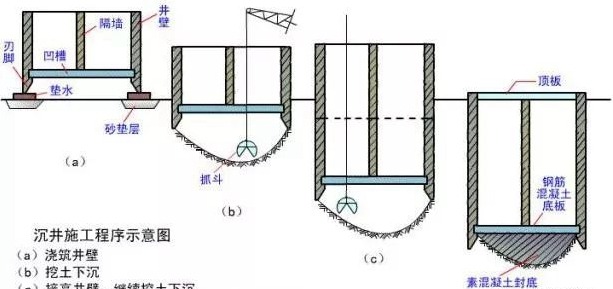
Advantages: low cost, good structural integrity, and easy quality assurance.
Disadvantages: It is difficult to rectify the deviation of large caissons. When sinking without drainage, it is difficult to unearth. Excavation has a great impact on the surrounding environment and will form a funnel-shaped ground. When caisson construction is used, it may cause air pressure disease, etc.
5. Deep foundation pit construction method
5.1. Underground continuous wall
(1) According to the wall forming method, it can be divided into: 1. Pile row type 2. Grooved plate type 3. Combined type
(2) According to the purpose of the wall, it can be divided into: 1. Anti-seepage wall 2. Temporary retaining wall 3. Permanent retaining wall (load-bearing) 4. As a foundation
(3) According to the wall material, it can be divided into: 1. Reinforced concrete wall 2. Plastic concrete wall 3. Cured mortar wall 4. Self-hardening mud wall 5. Prefabricated wall 6. Mud tank wall 7. Post-tensioned prestressed wall 8. Steel walls.
(4) According to the excavation conditions, it can be divided into: 1. Underground retaining wall (excavation) Underground anti-seepage wall (no excavation).
Due to the limitations of construction machinery, the thickness of underground diaphragm walls has a fixed modulus and cannot be flexibly adjusted according to pile diameter and stiffness like cast-in-place piles. Therefore, underground diaphragm walls can only show economical and unique advantages in foundation pit projects with a certain depth or other special conditions.
Generally applicable to the following conditions:
1. Deep foundation pit projects with a depth of more than 10 meters.
2. Projects where the enclosure structure is also part of the main structure and has strict requirements for waterproofing and impermeability.
3. The reverse construction method is adopted. When the above-ground and underground construction is carried out simultaneously, underground continuous walls are generally used as the retaining walls.
4. There are buildings (structures) with high protection requirements nearby, and projects with high deformation and waterproofing requirements for the foundation pit itself.
5. The space in the foundation pit is limited, the outer wall of the basement is very close to the red line, and other enclosure forms cannot meet the construction and operation requirements of the project.
6. In ultra-deep foundation pits, such as 30m-50m deep foundation pit projects, when other enclosures cannot meet the requirements, underground continuous walls are often used as the enclosure structure.

5.2. Sheet piles
A sheet pile is a kind of protective pile. Its shape is long and flat, and it can be used for the protection of low slopes, foundation pits, etc. Generally, it is driven in by force tamping.
Reinforced concrete sheet piles are a commonly used type of pile for pile wall-supporting structures. They have the characteristics of simple construction and short on-site operation periods. They have been widely used in foundation pits. However, hammering is generally used to drive reinforced concrete sheet piles. This method has high vibration and noise, and serious soil squeezing during the pile sinking process, so it is subject to certain limitations in urban projects. They are generally prefabricated in factories and then transported to the construction site, and the cost is slightly higher than cast-in-place piles. However, because its cross-sectional shape and reinforcement are more reasonable for the stress on sheet piles and can be designed according to needs, sheet piles with larger thicknesses (such as thicknesses up to 500mm or more) can now be produced, and there are hydraulic and static pile sinking equipment, so in Support board walls are still a form of use in foundation pit projects.
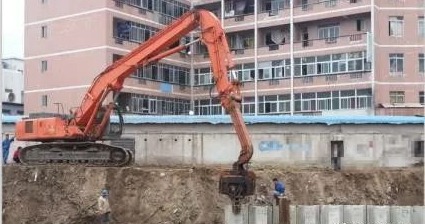
Sheet piles can extend the seepage path and reduce the seepage slope. In water conservancy and hydropower construction, sheet piles are generally located on the upstream side of buildings that need to be anti-seepage, usually in sandy soil.
5.3. Arrangement of piles
The pile row is a foundation pit supporting structure composed of certain pile types arranged in a queue. The most commonly used pile types are reinforced concrete bored piles and bored piles, as well as I-beam piles or H-shaped steel piles.
Applicable conditions:
1. Suitable for foundation pit side wall safety levels one, two, and three;
2. The cantilever structure should not be larger than 5m in soft soil sites; 3. When the groundwater level is higher than the bottom of the foundation pit, dewatering, pile rowing, and water interception curtains or underground continuous walls should be used
skills requirement:
1. The pile diameter of the cantilever pile row structure should not be less than 600 mm, and the pile spacing should be determined based on the stress of the row of piles and the stability conditions of the soil between the piles;
2. The top of the row of piles should be connected with a reinforced concrete crown beam. The width of the crown beam in the horizontal direction should not be less than the pile diameter, and the height of the crown beam in the vertical direction should not be less than 400 mm. The concrete strength grade of the pile row and crown beam on top of the pile should be greater than C20. When the crown beam is used as a connecting beam, it can be reinforced according to the structure.
5.4. External pull anchor (soil anchor) method
Soil anchors are referred to as soil anchors. It is to drill holes in the unexcavated soil layer of the deep foundation soil wall. After reaching a certain depth, materials such as steel bars, steel pipes, steel wire bundles, and steel strands are put into the holes, and mud or chemical slurry is poured into them to make them mix with the soil. The layers combine to form an anchor with strong tensile (pull-out) strength. The end of the anchor rod is connected with the retaining pile to prevent the soil wall from collapsing or landslides. Since there are no supports in the pit, the construction conditions are better.

Thank You
